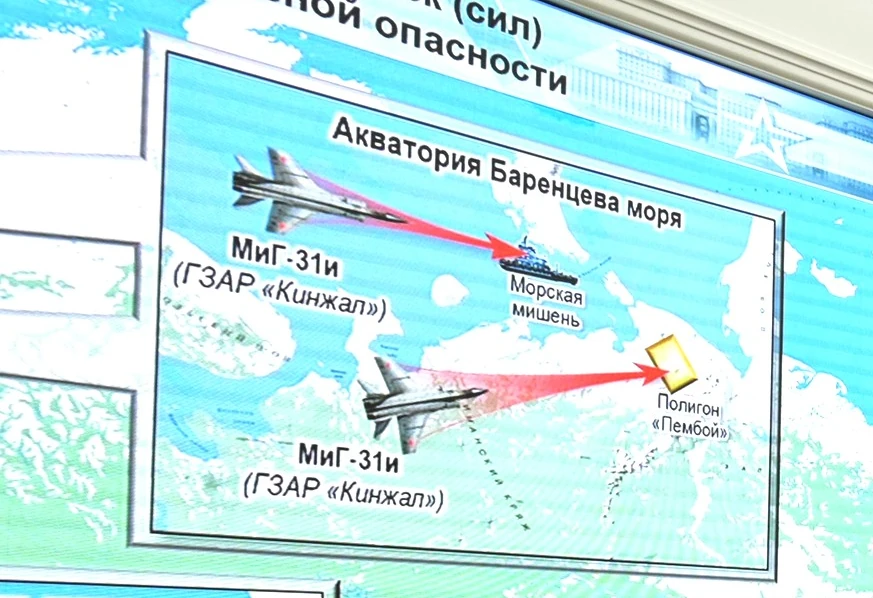On August 18, the Russian Ministry of Defense announced that it had deployed three MiG-31I aircraft with Kinzhal missiles in the Kaliningrad region. The aircraft were re-deployed to the Chkalovsk airfield in the Kaliningrad region. “Starting tomorrow (August 19), round-the-clock combat duty of the MiG-31I will be organized at the airfield,” it said.
The Russian Defense Ministry also showed a video of the transfer of fighter interceptors. The footage shows the sequenced landing of the aircraft and then shows the airfield parking lot, where three MiG-31I fighters are located.
This is the first time the “I” designation has been used to denote the MiG-31. Kinzhal missiles were initially deployed on Mig-31K fighters, similar to those used in Syria.
Mig-31I interceptor version features unique digital systems for the first time, including an electrical remote control system and onboard computers. They enable the fighter to be brought to the desired launch trajectory and launch the hypersonic missile at a precisely calculated moment in fully automatic mode, without the pilot’s intervention.
The first MiG-31I prototypes have already been tested. They were especially active in the strategic forces manoeuvres that took place at the beginning of 2022. On February 19, a scheme was published on the Kremlin website in which the MiG-31I with the Kinzhal hypersonic missile hit a sea target and a ground facility at the Pemboi training ground as part of these manoeuvres.
The major distinction between the MiG-31I and the older version of the “K” is the presence of special electronic systems that improve the aircraft’s flight characteristics and capabilities. The electronic remote control system manages all processes. The computer receives all data: speed, altitude, and ground information. All of this makes the pilot’s job easier.

In Mig-31K, the pilots usually bring the aircraft to the required operating modes on their own. The necessary parameters are entered into the onboard computer systems, which are installed on the modified modification of the aircraft. However, the MiG-31K will continue to serve and will not be replaced by Mig-31I immediately.
Kinzhal missiles with a range of 1500 to 2000 kilometres represent the most recent type of strategic weapon. President Vladimir Putin first mentioned them in his 2018 address to the Federal Assembly. According to official figures, the rocket can reach Mach 10 (ten times the speed of sound). Given their ability to manoeuvre on the flight path, intercepting such hypersonic missiles is thought to be nearly impossible. Air defence systems may detect the missile too late and simply will not have time to react.
As part of Long-Range Aviation, a regiment of MiG-31 missile carriers armed with Kinzhal hypersonic missiles has already been deployed.
The MiG-31 was the first fourth generation Soviet fighter. It was originally designed to intercept cruise missiles and other complex air targets. The aircraft has exceptional speed, altitude, and flight distance capabilities, with the ability to accelerate to 3000 km/h and climb over 20 km. The flight range exceeds 3000 km. Various board modifications have been used as carriers of advanced weapons systems and even for spacecraft launches.
The decision to decommission the MiG-31 was debated in the early 2010s. However, it was ultimately decided to keep the aircraft in service and later modify it for the “Dagger” system.
After removing the radar, the first “dagger” version of the MiG-31K was installed with a new communication and target designation system. The aircraft’s centre of gravity has shifted due to the product’s size and weight. The pilots had to be retrained as a result of the modifications. Until now, only highly qualified crews could use the “Daggers,” which necessitated adhering to the speed limit and flight path.
The modified MiG-31K serves as the missile’s “first stage”. The fighter accelerates and gains high altitude, after which it launches. The target designation system allows the pilot to enter the missile target parameters directly from the aircraft.
The Ministry of Defense signed a contract with the RAC MiG company a year ago at the Army-2021 forum to repair and modernize MiG-31 aircraft into the carrier version of hypersonic “Daggers.” Representatives of the Sokol aircraft plant informed Deputy Defense Minister Alexei Krivoruchko in November of the same year that a modernized version of the MiG-31, an interceptor fighter with an electrical remote control system, was undergoing state tests in Russia.
There is an upgrade option for this aircraft in which the company switches from a mechanical control system to an electrical one, installing several computers onboard the Mig-31, said the company.
Russia has been preparing the infrastructure for the airborne forces receiving the Kinzhals in recent times. Several storages, repair facilities and testing sites are being built across Russia.
Russia has used Kinzal missiles in the special operations in Ukraine.
